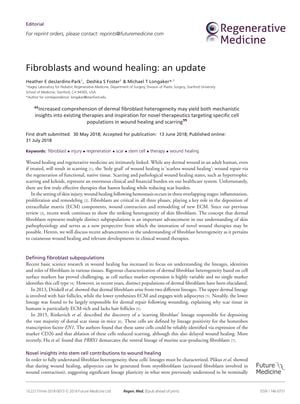TLDR Understanding different types of skin cells, especially fibroblasts, can lead to better treatments for wound healing and less scarring.
The document from 2018 discusses the critical role of fibroblasts in wound healing, emphasizing the need to understand the heterogeneity among fibroblast subpopulations to develop better therapeutic strategies. It points out that specific fibroblast lineages are primarily responsible for scar tissue formation, suggesting that targeting these cells could minimize scarring. The paper also examines the role of stem cells, particularly myofibroblasts, and their potential for therapeutic manipulation due to their lineage plasticity. Current therapies focused on fibroblasts, such as growth factor and cell-based therapies, are reviewed, with the suggestion that a deeper understanding of skin cell populations could enhance treatment efficacy. Additionally, the document proposes new research directions, including the targeting of fibroblast mechanotransduction pathways to reduce scarring, and predicts growth in wound healing therapeutics as knowledge of cell diversity in this process expands.
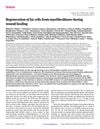 408 citations
,
January 2017 in “Science”
408 citations
,
January 2017 in “Science” Some wound-healing cells can turn into fat cells around new hair growth in mice.
1235 citations
,
December 2013 in “Nature” Two fibroblast types shape skin structure and repair differently.
 61 citations
,
October 2013 in “PLoS ONE”
61 citations
,
October 2013 in “PLoS ONE” Boosting Wnt signaling improves skin wound healing.
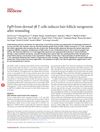 237 citations
,
June 2013 in “Nature Medicine”
237 citations
,
June 2013 in “Nature Medicine” A protein from certain immune cells is key for new hair growth after skin injury in mice.
 72 citations
,
April 2008 in “Organogenesis”
72 citations
,
April 2008 in “Organogenesis” Wnt signaling is crucial for skin and hair development and its disruption can cause skin tumors.
159 citations
,
January 2006 in “BMC Cell Biology” Wnt signaling can improve skin healing by promoting epithelial growth.
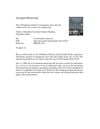 9 citations
,
November 2018 in “Drug Discovery Today”
9 citations
,
November 2018 in “Drug Discovery Today” Using skin stem cells and certain molecules might lead to scar-free skin healing.
908 citations
,
July 2015 in “British Journal of Dermatology” Acute wounds heal well, but chronic wounds struggle due to ongoing inflammation and poor tissue repair.
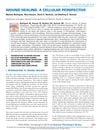 1160 citations
,
November 2018 in “Physiological Reviews”
1160 citations
,
November 2018 in “Physiological Reviews” The document concludes that better targeted treatments are needed for wound healing, and single-cell technologies may improve cell-based therapies.
 April 2024 in “Military Medical Research/Military medical research”
April 2024 in “Military Medical Research/Military medical research” Cellular and immunotherapies show promise for healing chronic wounds but need more research.
33 citations
,
February 2024 in “International Journal of Molecular Sciences” Understanding fibroblast issues in diabetic foot ulcers is key to creating better treatments.
